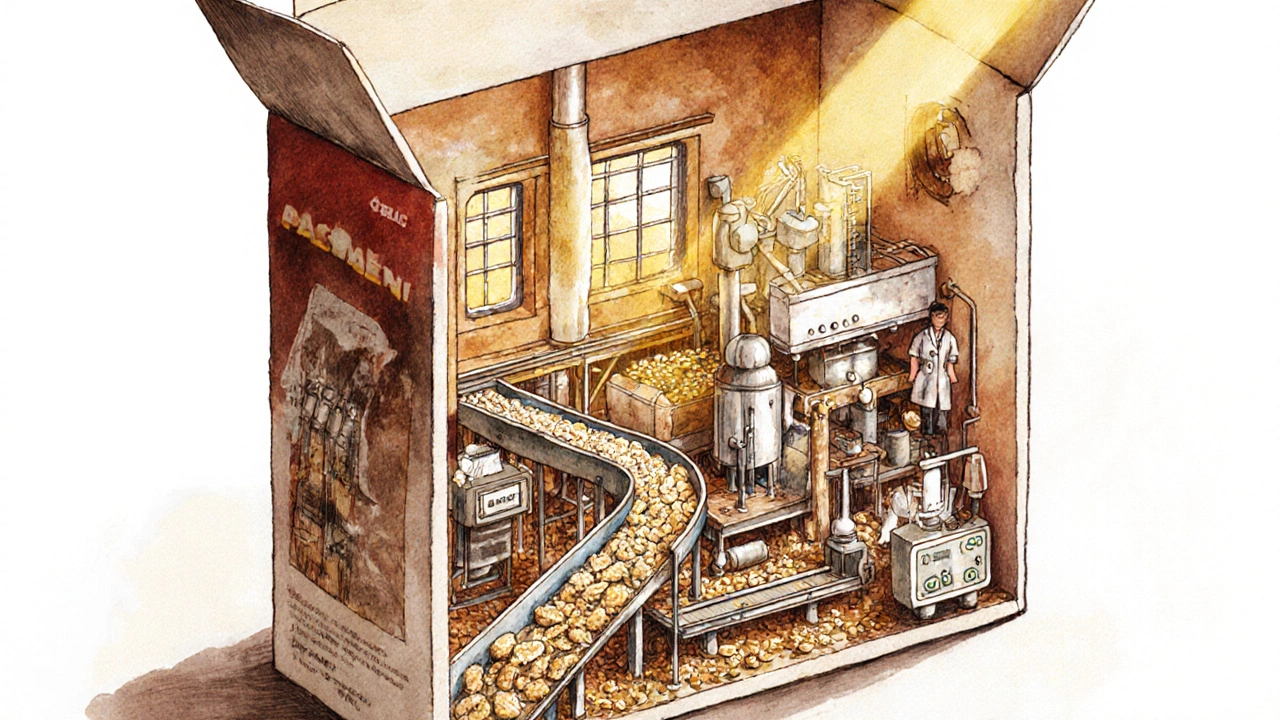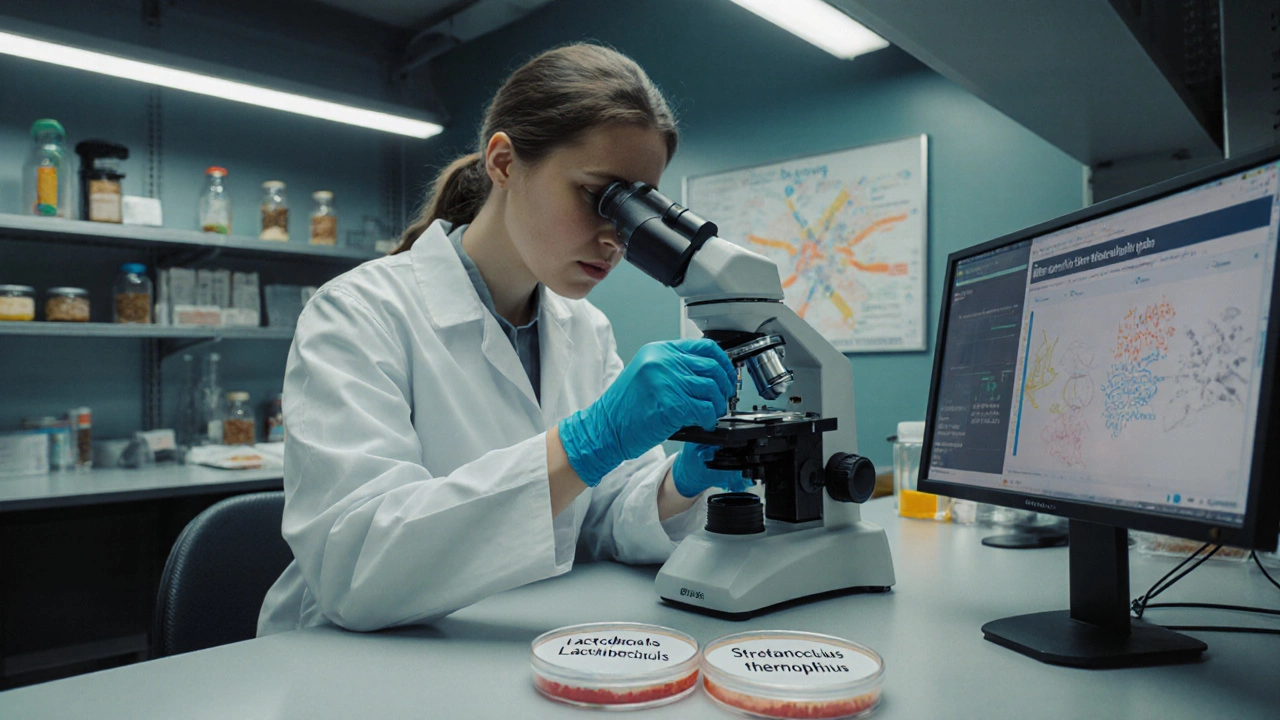Fermentation Time Calculator
Yogurt Fermentation Calculator
Calculate how long your yogurt needs to ferment based on temperature and bacterial strain. This tool demonstrates the science behind yogurt production described in the article.
Fermentation Results
Based on food science principles described in the article
Note: Temperature is critical in fermentation. At 40°C, the bacteria convert lactose to lactic acid through controlled microbial activity.
When you bite into a crisp apple, savor a slice of warm bread, or taste the saltiness of your favorite chips, you’re not just enjoying flavor-you’re experiencing a complex scientific process. The science of eating isn’t just about taste buds or calories. It’s the full story of how food is made, how it interacts with our bodies, and why we crave certain things over others. This field is called food science.
What Exactly Is Food Science?
Food science is the study of the physical, chemical, and biological properties of food. It covers everything from how milk turns into cheese, to why frozen strawberries lose their texture, to how packaging keeps snacks fresh for months. It’s not the same as nutrition science, though the two overlap. Nutrition focuses on how food affects health-like how vitamin C prevents scurvy. Food science asks: How do we make that vitamin C stay in the fruit during transport? How do we turn raw potatoes into crispy fries without turning them into charcoal?
Think of food science as the engineering behind your dinner. It’s the reason your peanut butter doesn’t separate in the jar, why your cereal stays crunchy in milk, and how instant coffee dissolves so quickly. It’s also why you can buy strawberries in December-even though they don’t grow naturally in the UK winter.
How Food Science Works in Real Life
Food scientists don’t just work in labs. They’re in factories, farms, grocery stores, and even restaurants. In Birmingham, for example, food processing plants turn local apples into juice, pork into sausages, and wheat into flour-all under strict food safety rules. These processes rely on food science principles like pasteurization, fermentation, and freeze-drying.
Take yogurt. It’s not just milk with bacteria added. The bacteria used-Lactobacillus and Streptococcus thermophilus-are carefully selected strains. They ferment lactose into lactic acid, which thickens the milk and gives yogurt its tang. Too little acid? It tastes watery. Too much? It’s sour and grainy. Food scientists tweak temperature, time, and bacterial ratios to get the perfect balance every time.
Even something as simple as bread involves science. Yeast eats sugar and releases carbon dioxide, making the dough rise. But if the dough gets too hot, the yeast dies. Too cold, and it won’t activate. That’s why professional bakeries use climate-controlled proofing rooms. Home bakers might not think about it, but the rise of their loaf is a controlled chemical reaction.
The Five Core Areas of Food Science
Food science breaks down into five main branches, each playing a role in what ends up on your plate:
- Food Chemistry - Studies the molecules in food: proteins, fats, carbohydrates, enzymes, and additives. For example, why does meat turn brown when grilled? It’s the Maillard reaction-a chemical change between amino acids and sugars.
- Food Microbiology - Focuses on bacteria, yeasts, and molds. Some make food safe (like in cheese and kimchi), others cause spoilage or illness (like Salmonella in undercooked chicken).
- Food Engineering - Deals with machinery and processes: how to pump, mix, heat, cool, and package food at scale. Think conveyor belts in a cereal factory or high-pressure processing to kill pathogens without cooking the food.
- Sensory Science - How we perceive food through taste, smell, texture, and sound. Why do some people hate cilantro? It’s genetic. Why do carbonated drinks feel refreshing? It’s the tingling sensation from dissolved CO₂.
- Nutritional Science - While separate, it’s closely tied. This branch looks at how food affects the body’s health, energy, and disease risk. Food scientists use this to design fortified foods-like iodized salt or vitamin D-enriched milk.

Food Science vs. Food Processing
People often confuse food science with food processing. But they’re not the same. Food processing is the *action*-turning raw ingredients into packaged products. Food science is the *knowledge* behind that action.
For example, a factory that cans tomatoes is doing food processing. The scientists who figured out how to preserve the tomatoes without losing flavor or nutrients, prevent botulism, and make the cans stackable without bursting? Those are food scientists.
Modern food processing relies on food science. Ultra-high-temperature (UHT) milk doesn’t need refrigeration because food scientists discovered the exact temperature and time needed to kill all microbes without cooking the milk. That’s why you can buy shelf-stable milk in rural areas or on long-haul flights.
Why Food Science Matters More Than Ever
Today’s food system faces huge challenges: climate change, food waste, supply chain disruptions, and rising demand for plant-based alternatives. Food science is the tool we use to solve them.
Take lab-grown meat. It’s not magic-it’s cell biology, bioreactors, and nutrient media developed by food scientists. Or plant-based burgers that bleed like beef? That’s not food coloring. It’s heme, a molecule found in soy roots, isolated and replicated using fermentation. The Impossible Burger uses this exact science.
Food waste is another big issue. In the UK, households throw away 4.5 million tons of food each year. Food scientists are developing smarter packaging-like oxygen-absorbing films and time-temperature indicators-that tell you if food is still safe, not just when it expired. Some new packaging even releases antimicrobial agents slowly to extend shelf life.
What You Can Do With Food Science Knowledge
You don’t need to be a scientist to appreciate food science. Understanding it helps you make smarter choices:
- Why does “no added sugar” on a label still mean high carbs? Because food scientists use natural sweeteners like fruit concentrate, which still spike blood sugar.
- Why does “organic” not always mean healthier? Organic cookies still have sugar and fat-food science just ensures they’re made without synthetic pesticides.
- Why does your frozen pizza taste better reheated in the oven than the microwave? Heat distribution. Ovens dry the crust slightly, activating Maillard reactions. Microwaves just steam it.
Even home cooks use food science. Marinating meat with vinegar or lemon juice breaks down proteins (tenderizing). Adding salt to pasta water raises the boiling point slightly, cooking noodles more evenly. These aren’t tricks-they’re applied chemistry.

Common Myths About Food Science
There’s a lot of misinformation out there. Here are three myths busted by real science:
- Myth: “Artificial flavors are unsafe.” Truth: Many artificial flavors are chemically identical to natural ones. Vanillin (artificial vanilla) is the same molecule as the one in vanilla beans. The difference is cost and consistency.
- Myth: “Preservatives are poison.” Truth: Preservatives like sodium benzoate or potassium sorbate prevent deadly bacteria like botulism. Without them, canned foods would be far more dangerous.
- Myth: “Whole foods are always better than processed.” Truth: Fortified breakfast cereals with iron and B vitamins prevent deficiencies. In many countries, this has reduced anemia rates dramatically.
How Food Science Touches Your Daily Life
Every time you open a carton of plant-based milk, grab a protein bar, or microwave a ready meal, you’re interacting with food science. It’s in the foam on your latte (stabilized by proteins), the chewiness of your gummy candy (controlled gelatin concentration), and the crispness of your frozen fries (blanched and dried to remove excess moisture before frying).
Even the shape of your cereal-why it’s a loop, a flake, or a puff-isn’t random. It’s designed for texture, shelf life, and how well it holds milk. Food scientists test these shapes in labs using high-speed cameras and sensors to measure crunch and dissolution rates.
Food science is invisible because it works. When it fails, you notice-spoiled milk, soggy chips, or a sauce that separates. But when it works perfectly, you don’t think about it. And that’s the point.
Is food science the same as nutrition?
No. Nutrition science looks at how food affects health-like how calcium builds bones or how sugar affects insulin. Food science looks at how food is made, preserved, and processed. They overlap, but one is about biology and health, the other about chemistry and engineering.
Do food scientists work in kitchens?
Some do, especially in product development for restaurants or food brands. But most work in labs, factories, or research centers. They’re more likely to be testing pH levels or running microbial tests than flipping burgers.
Can food science make food healthier?
Yes. Food scientists reduce salt in soups, replace trans fats with healthier oils, and create low-sugar versions of popular foods using natural sweeteners. They also develop ways to boost nutrients-like adding omega-3s to eggs or calcium to orange juice.
Why do some foods taste different in different countries?
Ingredients vary by region-different milk fats, wheat strains, or water mineral content. Food scientists adjust recipes locally to match consumer preferences. For example, Coca-Cola in the US uses high-fructose corn syrup, while in the UK it uses cane sugar. That’s why some people say the UK version tastes better.
Is all processed food bad?
No. Processing includes simple things like freezing, pasteurizing, or canning-methods that preserve safety and nutrition. The problem isn’t processing itself, but the addition of too much sugar, salt, or unhealthy fats in ultra-processed foods. Food science helps reduce those, not create them.
What Comes Next in Food Science?
The future of food science is already here. Researchers are developing edible packaging made from seaweed, using AI to design new flavors, and growing meat in bioreactors without animals. They’re even engineering crops to need less water and survive hotter climates.
One day, your grocery store might offer personalized nutrition packs-meals designed for your DNA, gut bacteria, and activity level. That’s not sci-fi. It’s the next step in food science.
So when you eat your next meal, remember: it’s not just flavor. It’s chemistry, biology, engineering, and decades of research-all working quietly behind the scenes to make your food safe, tasty, and available.






